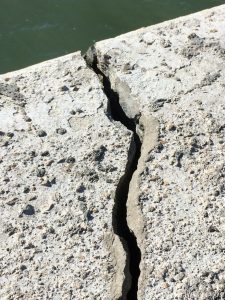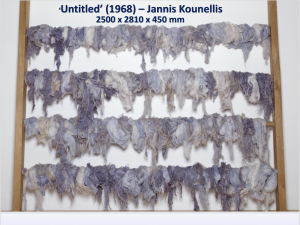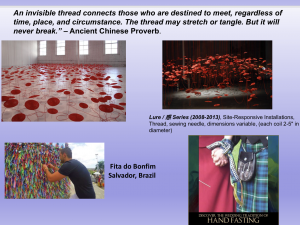 “...we must come down to earth from the clouds where we live in vagueness and experience the most real thing there is: material (1937)”.
“...we must come down to earth from the clouds where we live in vagueness and experience the most real thing there is: material (1937)”.
This quote from the artist and weaver Anni Albers seems to underline the thinking behind the elements of the workshop activity we led along with Professor Clare Saunders and Anjia Barbieri as part of the RepairActs Seminar in Penryn 17-18th October 2019. This seminar was an opportunity for academics and artists to meet together to explore ideas, provide peer support, collaborate and challenge and explore language/lexicons, theories and practices around this issue of repair
In our part of workshop we wanted to focus on the dislocation of material relationships felt in modern times and on our response when hearing a documentary about small children mending broken threads under the first weaving machines in industrial settings at the very beginning of the Industrial Revolution. This was a time which seemed to represent a breaking away of connecting with matter, with the material, as the industrialisation of production – of things sometimes previously made in the home, took hold. We also wanted to explore the possibilities of repairing those relationships.
We started our workshop by introducing our project
and sharing an example of Alison’s work which helps us to see unwanted and unnoticed materials in new ways,
We then invited participants to take and handle some raw Cornish wool fleece and tease and twist it into a a plied yarn, reconnecting with a process which is at the basis of all textile production. We encouraged them to feel, smell, experience the fleece as they created a thread. We invited participants to carry on with this as we talked. Interesting conversations transpired about how we relate to materials, a subject that we are not encouraged to discuss or explore.
Next, we shared how the starting point of our thinking about repair was the tying of knots to join broken threads underneath the ‘spinning mule’ machinery at the start of the European Industrial Revolution. As noted above, this era was the start of industrial processes which increasingly separate us from materials and their journey of transformation into finished products. We read an extract from A Chance Child by Jill Paton Walsh, a book that vividly brings to life and describes the working conditions of child workers during the Industrial Revolution.
But we also wanted to explore how broken threads can be repaired, how relationships with them can be reimagined. Alison introduced Untitled by the Greek artist Janis Kounellis. This work seemed to exemplify to Alison how elemental materials are; in this case sheep’s wool, with soft blue dye, seemed to represent and be a part of the sky, the wind, the rain, and the landscape that produced it, emphasising the connection between us, the material and the wider biosphere.
We looked at different traditions which use thread, often red thread, to connect and communicate love and devotion. Raksha Bandhan is the Hindu Festival that celebrates brotherhood and love. A sister gives a bracelet to her brother or a male friend to symbolise devotion and connection, the threads of the rakhi are considered sacred and to have protective qualities.
Red threads are used by the Chinese artist Beili Liu, drawing on the ancient Chinese legend of the Red Thread which suggests that when children are born, invisible red threads connect them to their soul mates, who they will eventually meet.
We also learned to make Celtic knots from a synthetic red cord sourced from a Scrapstore, this turned out to be bouncy and slippery and it was difficult to keep the knot knotted, showing one of the differences between natural and man-made fibres.
Interwoven into our elements of the workshop was a presentation by Clare and Anjia who shared the work they have been doing as part of their research project Sensibility for Sustainable Fashion (S4S) This included an opportunity to unravel woolen jumpers to make new yarn , a cost effective and environmental way to create yarn for knitting. It was wonderful to see the synergy between our two projects and to have the opportunity to meet and work with Clare and Anjia, who have been formally invited to submit evidence from the S4S project to the UK Parliamentary Inquiry into Sustainable Fashion. We have also made a representation to the inquiry, positing our ideas around materials and deep materialism.
At the end of the workshop we took the photo at the start of this post – red threads, plied fleece, unravelled wool and Celtic knots intertwined and knotted and connecting workshop participants.
As part of the seminar we also visited National Trust properties at Godolphin House andMullion Cove . These are both places where repair is explored on a larger scale. The National Trust must make decisions on what to repair enough to prevent further decay (an approach adopted at Godolphin) and what to allow to decay. It must curate decay as well as preservation. The issue of ‘curated decay’ (Desilva 2017) has a particular resonance at Mullion Cove where the strenght of storms (most likely linked to climate change) create the dilemma of managed retreat or repair and maintenance.

At Mullion we were able to see this crack opening up in the south harbour wall, a result of the storms in October 2017. This crack is forming along the line of a previous repair in the 1980s, despite extensive repairs carried out to the harbour wall using concrete after the storms of 2014.

The Trust’s stated plan for Mullion is to repair as long as this is feasible (i.e. funded by the insurers) but if an event occurs which makes repair not financially or logistically viable, then it is committed to a policy of ‘curated decay’. This is a controversial local issue and can be explored in more detail in chapter x of DeSilva’s recently published book Curated Decay.








